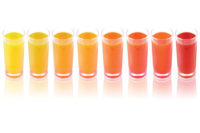Premix 101




Michael McBurney, Ph.D., is head of scientific affairs for DSM Nutritional Products Inc. and a fellow of the American College of Nutrition, as well as an adjunct professor at Tufts University, Boston, Friedman School of Nutrition Science and Policy. He holds his Ph.D. from Cornell University, Ithaca, N.Y. McBurney also co-writes the TalkingNutrition blog at http://bit.ly/akYMMi.
Developing a new product is challenging, especially when employing transformative innovations. Despite the value of product development brainstorming, research, focus groups and other background legwork, most of the time needs aren’t fully articulated until an initial solution is in hand. Whether building a product oneself or helping a client create—or recreate—a food, beverage or other item with a nutrition target in mind, getting the precise balance of nutraceuticals leaves precious little margin for error.
For example, what happens if developing a product for infant nutrition? Even a small error in measurement could make the difference between helping or harming the end-consumer. Take, for instance, the amount of vitamin A in the formula; if it makes up a mere 5% of the total amount of vitamins, minerals and nutraceuticals in the product, then 1kg will go into 20kg of that part of the recipe.
This amount is enough for eight tons of formula—enough to feed more than 9,000 babies. An error in that single, 1kg-pack of ingredient could thus ultimately—and adversely—affect thousands of babies. For this and other reasons, many manufacturers opt for a premixed solution when dealing with multiple quantities of different nutraceuticals.
More than ever, consumers are taking an active role in improving their health. People are looking for specific food components to maintain and improve health. According to a 2011 Gallup study, two out of three people are making an effort to consume foods and beverages that are fortified with nutrients. People choose fortified foods, because they know nutrition is essential. People understand that bodies require vitamins and minerals to support the immune system, cardiovascular health, bone health and more. The “HealthFocus Trend Report” (2011) says >60% of shoppers read labels on food packages. This was confirmed in 2012 by the International Food Information Council (IFIC).
According to the “2012 Food & Health Survey” by IFIC, 85% of consumers surveyed have given some thought to the safety of their foods and beverages. People would rather enjoy food than worry too much about what is in it. However, consumers must perceive the additional value. When it comes to food and health, this means linking nutrients with consumer needs.
However, consumers don’t choose foods for their nutritional content as much as for the benefits those and other essential nutrients provide. Vitamin D and calcium are desired to support bone health; vitamin C is sought to maintain a strong immune system. Products rich in antioxidants, like vitamin E, are selected to protect skin and other tissues from oxidative damage.
What Consumers are Missing
The most recent data from the CDC shows that 8% of Americans have vitamin C levels below that which leads to scurvy. Some 31% of non-Hispanic blacks are deficient in vitamin D. Almost 100% of Americans are not consuming the recommended daily amount (RDA) of vitamin E from their diet. For women 31-50 years of age, 80% are not meeting the RDA for vitamin A, >60% for vitamin K, 90% for dietary fiber, 40% for folate, and almost 90% for iron and magnesium.
Consumers are interested in health. Four out of five consumers polled in the “2011 IFIC Food & Health Survey” noted they will purchase a food or beverage, because it is fortified or contains a functional ingredient with a health benefit. Unfortunately, nutrition information is confusing. According to the “2012 Food & Health Survey” by IFIC, Americans find it easier to do their taxes than to eat well. People need assurance that the product tastes good and will deliver a health benefit.
Fortification is an important part of getting essential nutrients. Research by the International Life Sciences Institute finds many Americans have intakes below recommended levels for vitamins A, C, E, magnesium and potassium. Choosing foods that are enriched or fortified improves nutrient intakes and reduces the risk of inadequacy. Without enrichment and/or fortification, many Americans will not achieve the recommended micronutrient intake levels.
This means there is an unmet need for more fortified food and beverage products. “Naturally functional” foods—“foods with intrinsic health benefits”—are one of the biggest recent consumer trends. Moreover, consumers have a very positive attitude toward fortified foods. Functional foods, or foods fortified with added or concentrated ingredients to improve health and performance, are business opportunities—with 2010 U.S. sales exceeding $35 billion.
Fortunately, food manufacturers have opportunities to fortify items such as nutrition bars, beverages, ready-to-eat cereals and, to some extent, the dairy and toddler segments. They can also add new nutraceuticals and botanicals, along with conventional vitamins and minerals to support health.
Opportunity depends upon market size (number of potential consumers) and demand (loyalty, repeat business, etc.). Among adults, it’s known the top health concerns are maintaining mental acuity and physical ability as one ages. Close behind are cardiovascular, bone and eye-health concerns. Next is a desire for products that help manage energy/tiredness and appearance/skin health. These all are fertile areas for manufacturers to explore.
Product Formulation
The key challenge to creating new, nutrition-targeted products is being able to formulate a product that meets cost requirements, tastes good and meets quality expectations, including those for consistency. Blending ingredients to achieve shelf-stable, high-quality products is a science in itself. And, this is where premix technology has significant advantages.
Premixes are custom-designed, complex blends of any wide variety of ingredients. In most cases, they’re associated with ingredients specifically targeting health and wellness, i.e., ingredients such as vitamins, minerals, botanicals and other nutraceuticals used in the fortification of food, drinks and for supplement products.
By taking advantage of premix formulations that have been custom-designed and blended with scientific expertise via suppliers who can help generate concepts backed by strong nutrition science and regulatory guidance, the guesswork is completely removed, and risks are geometrically diminished. In this manner, product development can be simplified by using such premixes, and the fortifications become integrated into product formats optimized for different food applications.
Vitamins, minerals, nutraceuticals and botanicals often have different physical properties. Ingredient attributes—e.g., flakiness, very coarse granules, or light and fluffy particles—can make it difficult to integrate these ingredients homogeneously into finished products.
With specially-constructed premixes, formulation scientists and manufacturers can take advantage of basic blending principles, such as order of addition or pre-processing, to improve quality and reduce production costs. The premix supplier should also be able to help processors identify the ideal blender style, e.g., high or low shear; and ancillary equipment, e.g., screening, milling or pre-blends, to overcome special handling properties of new ingredients. The right premix can also reduce segregation among ingredients.
Premixed fortification ingredient systems can come in a variety of forms and combinations. Lipid-soluble vitamins, antioxidants and nutraceuticals (such as vitamins A, D, E and K); carotenes, lutein, zeaxanthine and lycopene; omega oils; and others can come in liquid, beadlet or micro-beadlet form. Some can even be spray-dried. Water-soluble vitamin, mineral, amino-acid and botanical compounds can be liquid or dry-blended.
There is a science to developing the optimum premix for food and drink applications. It begins with identifying and achieving desired specifications and allowable overages. It then involves determining and selecting proper market forms for each application.
When it comes to production, the goal is to create a homogenous blend. This may involve such parameters as appropriate particle-size distribution, and analyzing and ensuring its stability (process-stable ingredients) along the entire production chain through the selection of appropriate packaging. It also might mean offering flexible pack sizes to ensure quality and consistency.
All of this process has to be done without introducing variables that would lead to compromising taste or texture in the end-product.
Added Value
There also are added values to using premixed ingredients. Using premixes can reduce product development lead time, thereby improving product development efficiency. Custom blends can improve economics by reducing inventory costs, as well as the number of suppliers. Global suppliers with a range of ingredient forms and specially trained formulation experts can reduce complexity. Suppliers also can help identify and assemble the right quality ingredients to incorporate into and across the processors’ products and brands.
Suppliers also should possess the capability of running pilot trials to study interactions that affect stability, off-odors or taste—or any other scale-up technological problems. This will accelerate product innovation. Working closely with reliable ingredient suppliers can help formulation scientists and manufacturing engineers choose the best ingredient form and make on-the-go adjustments during the manufacturing process to ensure food-product quality. Premix suppliers with application expertise and innovation centers can play an important role in developing healthful blends to accelerate food-product innovation.
By looking to premixed ingredient systems for fortification, manufacturers can take advantage of robust blending principles that use state-of-the-art serial dilution tools. Choosing systems developed and created through such new, complex processes saves money and time. pf
Picking the Right Supplier
Finding the right supplier for a premix system can be as critical as the system itself. After all, a faulty premix will end up doing the opposite of its intended function. The right suppliers should be capable of offering customized service across the entire value chain.
Ask suppliers if they have the science to help substantiate product claims. Can these claims be used in all markets or only some? Is the claim supported with clinical trials specific to this ingredient? Suppliers who invest in clinical research will have science to support claims made with their ingredients. Ideally, select a supplier that is backward-integrated into the manufacturing process or can provide evidence that they have tight control over the sourcing of all their ingredients. With scientific support in hand, innovation can be faster.
High repeat-consumer demand will require an assured source of quality ingredients, delivered on time. As sales begin in new markets, additional product documentation is needed. Regulations require traceability, upstream and downstream. Work with experienced premix suppliers with knowledge of vitamins, minerals, nutraceuticals and botanicals. That experience will ensure that each and every premix has the same requirements. Choose global suppliers with established quality-control processes who offer inventory agreements, and who can ensure the premixes are readily available worldwide with proper local regulatory guidance.
Why Choose Premixes?
There are three main reasons processors should choose premixes for their better-for-you formulations:
Efficiency
Reduce complexity
Strategic alignment with suppliers
Development lead time
Economics
Reduce inventory costs
Secure supply
Reduce spending and number of suppliers
Quality
Reduce risk
Additional quality-testing steps
Blends produced by experts; specs guaranteed
Looking for a reprint of this article?
From high-res PDFs to custom plaques, order your copy today!






